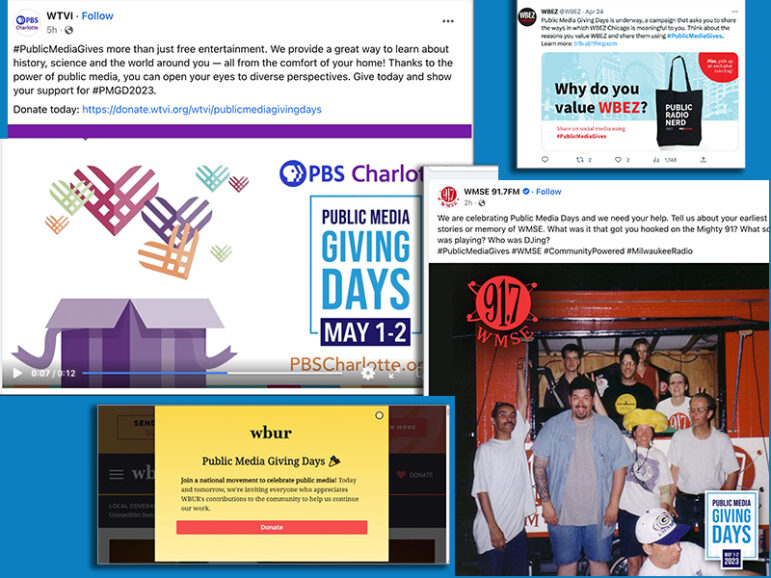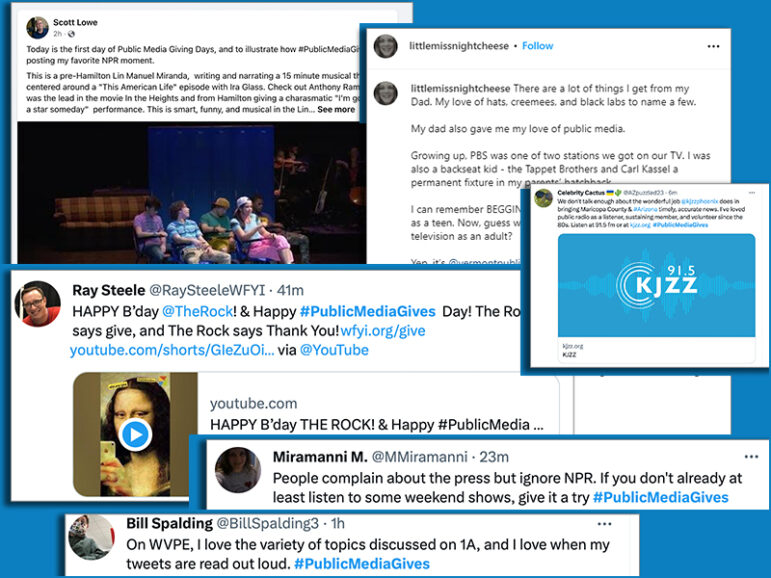How National Public Media Giving Days made a difference in 2023
SPONSORED
By our estimate, on May 1st and 2nd, over one hundred public media stations across the nation participated in Public Media Giving Days (PMGD), a two-day online fundraising event that aimed to raise awareness and support for public media. Our preliminary data shows the event was a success, with impressive results in terms of revenue, donor engagement, and average gift amount. While CDP, Greater Public, PBS and NPR will share more details and data in the near future, we did want to respond to questions by sharing some initial results. However, please remember these are initial station self-reported numbers. The results discussed below are from data shared by 64 surveyed stations, with an additional set of NPR data; therefore, they should not be considered “grand totals” across the system.

Day One, focused on advocating for public media, provided stations with an opportunity to promote their mission, with public media fans and donors themselves starting conversations about #PublicMediaGives as well as emailing notes and posting to social media about why they chose to support a station. In fact, some stations seized this opportunity to connect with their active donors on a deeper level. As one station representative shared, “We used this as an opportunity to reach out to active donors and ask them to be ambassadors for the station. We’re not yet sure exactly how we will use them, but we’re developing that plan now.” These ambassadors are an indication of how public media fans can amplify the impact and reach of public media—making advocacy on Day One an important component of Public Media Giving Days. The conversations and social media postings on Day One serve two purposes: First, to build community—as noted above—and second, to help drive donations on the following day. We know the community connections worked, but how did they impact revenue?

Another indicator of the success of PMGD was the high average gift amount of $113. This tells us donors were not only willing to give but also to give generously. Combined with the Day One advocacy, the high average gift amount also suggests that donors were motivated by the mission of public media, demonstrating their commitment and loyalty to what it can accomplish. While we obviously do not have long term value on these folks, we believe this is indicative of a strong lifetime value. Apart from station response, donor engagement was also evident in NPR fundraising. (NPR featured PMGD on their website.) Elyse Poinsett, Senior Director, Digital Philanthropy at NPR, noted, “Donor response on NPR’s digital platforms was strong, especially compared to past spring campaigns. It’s clear there’s plenty of good here to work with as we look forward to future Public Media Giving Days.”

Insights from the participant survey and station experiences shed light on the strategies employed during PMGD. These stations demonstrated their commitment by sending an average of 3.84 emails per station, posting nearly 10 times per station on social media platforms, and airing a remarkable 3,895 total on-air spots. The stations embraced various promotional methods, with 45% utilizing website ads, 24% employing website pop-ups, and 18% creating dedicated landing pages. Additionally, 53% of stations dedicated a specific donation page to streamline and better track the giving process, while 18% embraced the engagement potential of QR codes. Interestingly, initial analysis shows incremental revenue gains mostly plateau after messaging on two promotional channels—meaning Email + Broadcast promotion appears to function as well as Social + Broadcast or Social + Email. This may be an artifact of our limited dataset, but it does clearly demonstrate that, as hoped, this promotion does scale effectively to a station’s resource constraints.
While the data presented represents a preliminary indication of results, it’s evident that PMGD has already made a significant impact, raising over $700,000 in revenue and attracting new donors. As we eagerly anticipate the comprehensive data from the National Reference File (NRF) in mid-July, we thank the survey respondents for the initial data that allowed this initial view. These early results demonstrate the support for public media and set the stage for future campaigns. While it is more difficult to quantify, it is also important to note that PMGD has also engaged new donors and showcased the value of public media in people’s lives. We look forward to sharing the comprehensive results and stories of success and also announcing further plans for the future of PMGD, including dates for 2024, at the upcoming PMDMC in July. Check out more content and stay tuned for exciting updates on the success and impact of PMGD, including the follow-up analysis based on data from the NRF, on CDP’s blog.


